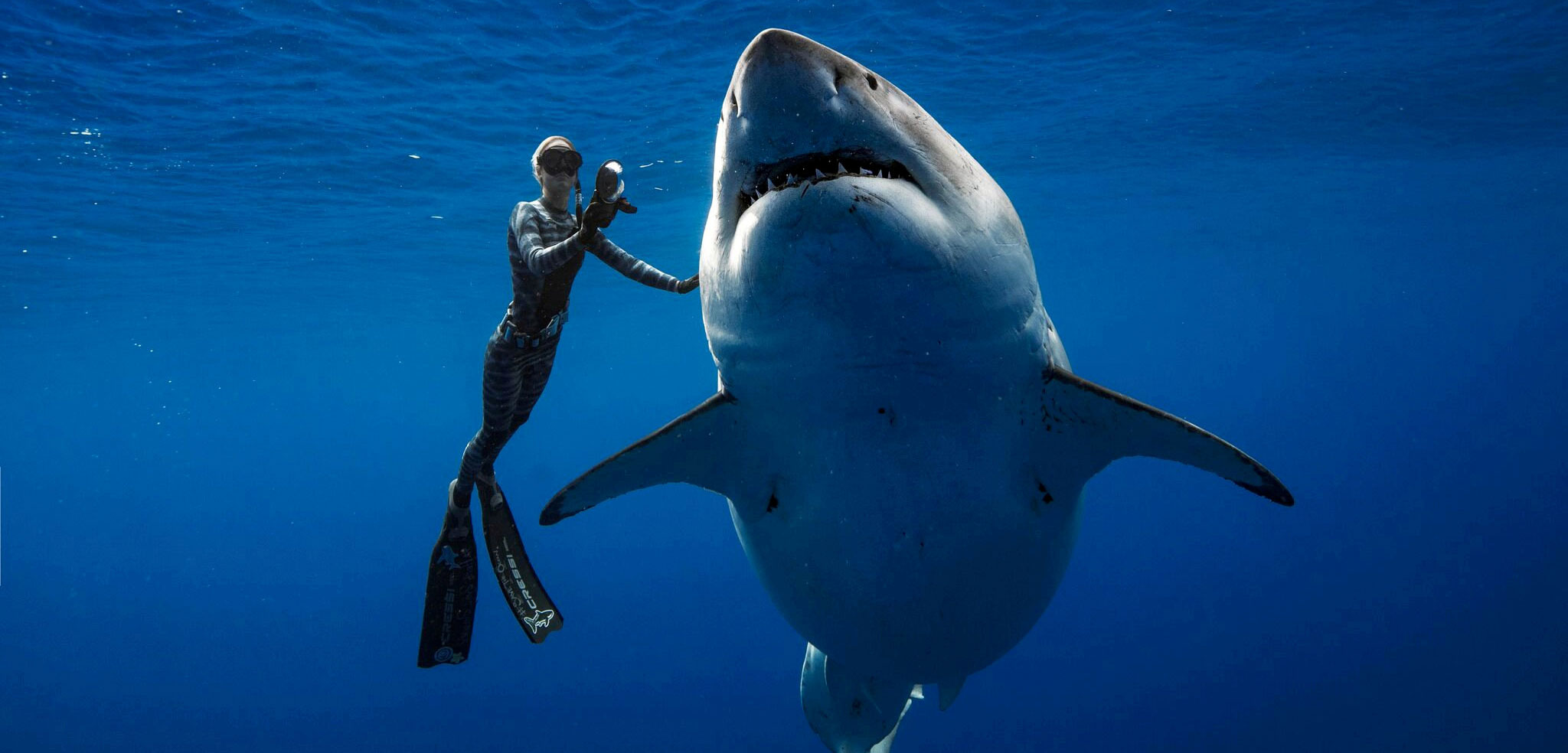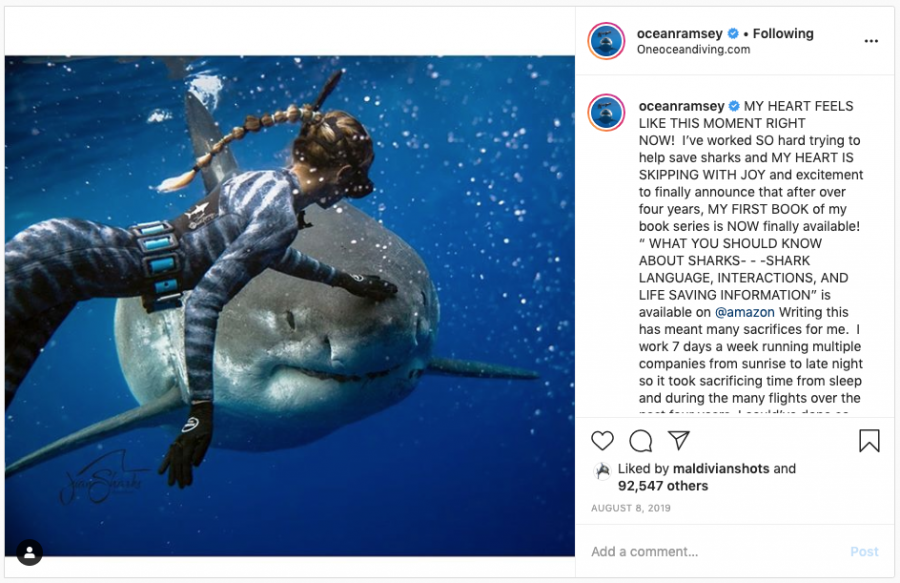When Photographers Get Too Close, Wildlife Pays the Price
Capturing up-close-and-personal animal encounters on camera can help garner public support for conservation, but at what cost?
Article body copy
Perched on a riverbank in California’s Point Reyes National Seashore, Daniel Dietrich scans the water’s edge through a pair of binoculars. The rising sun crests the surrounding hills, illuminating the coastal dunes and wetlands below.
Dietrich, a professional wildlife photographer and ecotour guide, homes in on a small patch of pennywort on the opposite bank. Somewhere beneath the bunches of succulent stems, he suspects, a family of river otters is hiding.
Point Reyes is one of the best places in California to observe river otters in their natural habitat. The ecological preserve, which extends across 287 square kilometers of coastline in Northern California’s Marin County, is a refuge for a diverse array of animals, including half of all bird species in North America.
But tracking down these animals can be tough. Fortunately, Dietrich has spent hundreds of hours following this family of otters across Point Reyes and knows its habits well. Most days, Dietrich wakes at sunrise and heads to the preserve and doesn’t leave until well after sunset. When Dietrich isn’t giving tourists and photographers tours of the park, he spends his time stalking bobcats—his favorite species to photograph. But today, that’s not what he is after.
“Otter, there on the dune!” exclaims Dietrich, eyes beaming. About 100 meters away, a long, lanky creature emerges from the shrubbery on the opposite bank, its cigar-colored coat silhouetted against the pale sand of the coastal dunes.
Dietrich, a tall, slender man with kind eyes and a stubbly, salt-and-pepper beard, watches intently as the otter, back arched and tail pointed up, trots along the water’s edge toward the mouth of the river. Dietrich follows it, moving as nimbly as a man with a camera the weight of a brick strapped to his belt possibly can.
He stops abruptly at a small footbridge. “This is close enough,” he says as he crouches down and removes his camera from its holster.
The otter, seemingly unaware of its stalkers, slides into the water about 40 meters away. After a minute or two below the surface, the charismatic carnivore pops its head out about 25 meters from us. Dietrich’s camera erupts in a flurry of clicks. The otter dives once more, this time re-emerging with a crab in its clutches. As we watch the otter tear limb after limb from the writhing crustacean, a gentle current starts pulling the floating otter away.
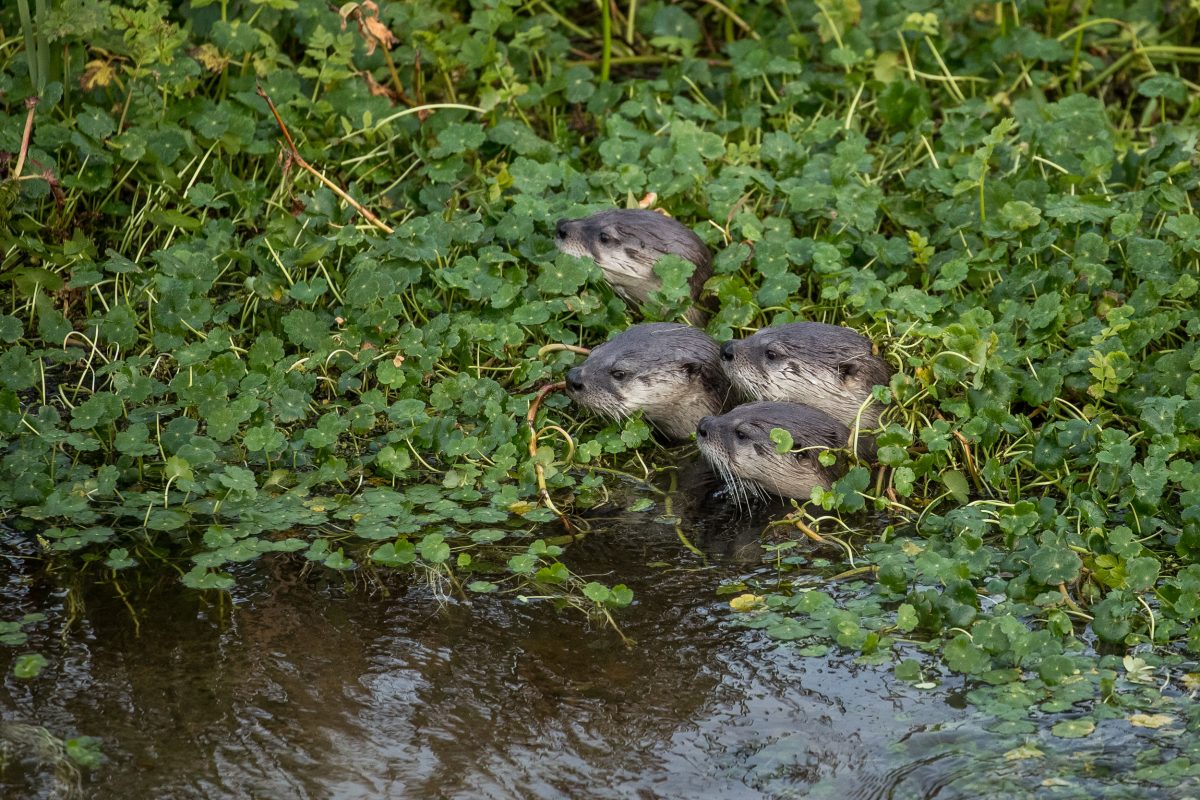
River otters poke their heads out of a patch of pennywort, giving photographer Daniel Dietrich a chance to capture them in their natural habitat. Photo by Daniel Dietrich
Mashing the shutter button of my own camera, I can see the appeal of following the animal down the riverbank. If I were to take just a few more steps, I could get a photo of a wild river otter feeding—something that would be sure to garner at least 100 likes if I posted it to my Instagram account. I wait for Dietrich to give the signal to pursue the otter, but it doesn’t come.
“We don’t want to get too close,” he says. Any further encroachment, he explains, could frighten the animal—and that’s the last thing he wants to do.
When it comes to wildlife photography, Dietrich, who sits on the ethics committee for the North American Nature Photography Association, follows a simple credo: the welfare of his subjects always comes first. Even though it makes his job more difficult, Dietrich always maintains a safe distance between himself and his subjects and refuses to use bait or calls to attract them. When wildlife photographers use these shortcuts, Dietrich says, they are doing so at the expense of their subjects.
Over the past few decades, scientists have learned a great deal about the dangers of disturbing wildlife. It’s now clear that chasing, baiting, and getting up close and personal with wild animals can jeopardize their health and well-being.
Unfortunately, close-ups and close calls get clicks, so some wildlife photographers, filmmakers, and media personalities still use questionable, even unethical, strategies to get their shot. The problem is particularly evident on social media, where dramatic photos of animals are rapidly shared by users who don’t take the time to consider what might have gone into capturing them.
Some of the most problematic wildlife imagery online today is being posted by self-proclaimed conservationists who argue that their evocative content helps raise awareness about conservation issues. Although spurring action through compelling photography is certainly worthwhile, Dietrich and other leading wildlife photographers have begun speaking out against those who disturb wildlife under the guise of raising awareness.
Disturbing wildlife for content creation is becoming a widespread problem, Dietrich says as we walk back up the riverbank toward his car. “A long time ago the general public didn’t have access to this type of equipment,” he says, gesturing toward his camera. “And fewer people were doing it [photography], so bad behavior had less of an impact back in the day.”
But as cameras got cheaper and social media gave everyone a platform to publicly share their photos and videos, Dietrich says, the number of people interested in wildlife grew exponentially.
People take and share wildlife photographs for different reasons, Dietrich says. “Some people do it just for the sheer love of nature, some people do it for personal gain, and some people just do it for the limelight.”
In the modern media landscape, wildlife imagery is in high demand. Posting captivating photos or videos of exotic animals on social media can get you legions of followers, corporate sponsorships, and mainstream media attention. This is true for wildlife photographers who capture nature’s beauty in earnest, ethical ways and for those who take shortcuts at the expense of their subjects.
Too often though, questionable or unethical behavior by content creators—professional and amateur—is rationalized by those who believe being well poised to raise awareness gives them the right to operate with impunity.
Take, for example, Instagram influencer and shark conservation advocate Ocean Ramsey. In January 2019, Ramsey made international headlines after publishing photos of herself getting up close and personal with a six-meter great white shark that experts suspect was pregnant.
Ramsey and her husband, Juan Oliphant, owners of the Hawai‘i-based dive charter company One Ocean Diving, were freediving off the coast of O‘ahu when a massive great white shark approached their boat. The shark had come to feed on a whale carcass floating nearby. As the barrel-bodied creature approached the carcass, Ramsey dove down and ran her hand along its back. When the shark moved out of reach, Ramsey swam after it and stroked it a second time. As the encounter unfolded, Oliphant and three other freedivers moved in to capture photos and videos.
Despite the controversy surrounding such behavior, when images of Ramsey touching the gargantuan great white shark were posted to Facebook and Instagram, they quickly went viral. “Beyond magic! Please #helpsavesharks!!!!” Ramsey wrote in the caption of one of the many Instagram posts depicting the dive. “So grateful for this magical encounter and the opportunity to raise awareness for sharks on a global scale,” she wrote in another.
The post certainly did raise awareness, but perhaps not in the way Ramsey had hoped. The day after Ramsey made the details of her encounter public, dozens of people reportedly visited the sperm whale carcass, forcing the Hawai‘i Division of Conservation and Resources Enforcement to put out a press release urging people to “stay out of the water around this carcass,” adding, “Understandably, some people want to get into the water either out of fascination or to get photographs, but it is truly dangerous to be around this carcass with so much shark activity.”
As soon as images of Ramsey’s encounter were posted online, prominent marine biologists, including Michael Domeier, a leading shark expert and founder of the Marine Conservation Science Institute, began to chastise Ramsey on social media, arguing that her actions jeopardized the well-being of the shark and other divers in the water.
“It was a very unwise behavior that could potentially cause many people to want to do the same thing,” says Domeier. “There is a strange disconnect between what people think is okay to do on land and what people think is okay to do in the water. You would never go on a safari and try to grab a lion’s mane.”
Forcing an animal to interact with you, whether on land or at sea, is never a good idea, says Dan Blumstein, a professor of ecology and evolutionary biology at the University of California, Los Angeles. “Many species treat us like predators, and the same way they respond adversely to predators, they respond adversely to our activity,” says Blumstein.
When an animal feels threatened, it responds in one of two ways: fight or flight. Both responses require a lot of energy and can result in missed feeding and mating opportunities.
These responses can have deadly consequences. For example, female harbor seals have been known to abandon their pups if their haulout sites are disturbed. Similarly, Atlantic puffins may discard their eggs if disturbed while nesting. For nomadic species, such as caribou and manatees, even one disturbance can cause them to leave safe areas and venture into dangerous territories.
And in many parts of the world, animal control agencies are required to euthanize any animal, regardless of whether it is captive or wild, that attacks a human—even if the attack was provoked.
In the end, whether an animal is harassed or habituated because of ignorance or willful disregard or in the name of raising awareness, it’s the animal that pays the price.
When the details of Ramsey’s daring encounter came to light, scientists were quick to raise these issues.
According to Domeier, the shark Ramsey touched appeared pregnant and by forcing it to interact with her, she risked scaring it away from the whale carcass.
“A pregnant female white shark spends almost 18 months in the open ocean where prey is few and far between, so you don’t want to risk scaring one away from a meal that it needs to take care of the 500 or 600 pounds [225 or 275 kilograms] of babies it’s carrying,” says Domeier.
In some places, law enforcement and conservation organizations have begun taking steps to prevent wildlife disturbance in their communities. In 2015, marine biologist Gena Bentall founded Sea Otter Savvy, an organization dedicated to reducing human-caused disturbances of sea otters along the coast of central California.
According to Bentall, the best way to protect wildlife from disturbances is to educate people before they enter wild spaces. She says this strategy works well on ecotourists but admits that it isn’t always enough to convince offending wildlife photographers to change their ways.
“Wildlife photographers tend to portray themselves, often accurately, as wildlife conservationists, so they don’t like to be told that something they’re doing might have a negative impact on wildlife,” says Bentall. One time, she says, a photographer argued that his disturbance of a sea otter was a small price to pay for the attention his intimate photos could bring to the plight of the species.
When scientists publicly rebuked Ramsey’s actions, the social media star, who did not reply to requests for comment, used a similar defense.
“The main goal is protection for sharks,” Ramsey told the Washington Post. “I need people to see that they’re not monsters so that they can care enough, or respect them enough, just to give them the same protection that dolphins and whales have been given.”
Unsurprisingly, Domeier and other scientists took issue with her rebuttal.
“When people say, ‘It’s all about saving sharks,’ I just have to put my hands up and say, ‘No,’” says Domeier. “Sharks are gorgeous without being ridden, and we can take pictures of them that get the [conservation] message across.”
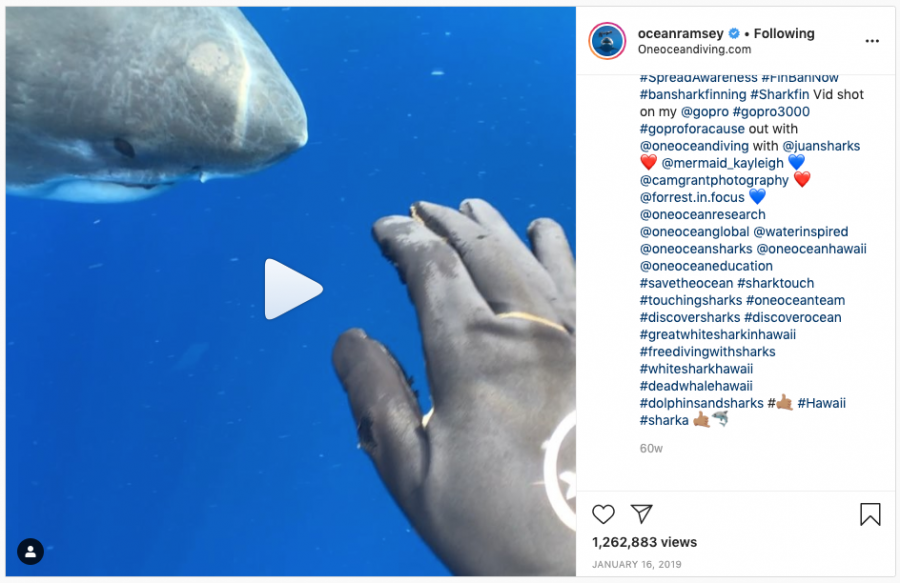
This screenshot depicts a second video of Ramsey running her hand along the shark’s back. It was originally posted to Instagram but has since been removed.
Ramsey’s attempt to portray great white sharks as benevolent is not only irresponsible, Domeier argues, but also counterproductive to their conservation.
“Great white shark populations are coming back after decades of hard work, conservation, and research,” says Domeier. “And every time an interaction between a person and a white shark doesn’t go well, the chance of the pendulum swinging from where it is now, where lots of people appreciate and want to protect white sharks, … back to the 1970s after Jaws, when everyone wanted to kill every shark in the ocean, gets much greater.”
Ramsey is just one of many influencers on social media who disguise their unethical encounters with wildlife as noble acts aimed at raising awareness. Kelvin Peña, who goes by the handle Brother Nature, ruffled feathers last year when he posted a video of himself on Twitter harassing, and being bitten by, a wild African penguin, with the statement, “Sadly, African penguins are now an endangered species due to the uncontrolled harvesting of penguin eggs for food & guano scraping.”
These African penguins are some savages 😂 pic.twitter.com/11RjsF0I1Q
— Brother Nature (@BrotherNature) February 23, 2019
Similarly, Michael Holston, known as the Real Tarzann on social media, has asserted that the photos and videos he posts of himself petting tigers, chimpanzees, and elephants help promote animal education and conservation. Ironically, many of Holston’s posts do not contain any educational information. Furthermore, most of the creatures Holston cuddles for his followers’ amusement are captive-born animals bred for the exotic pet trade and entertainment industry, both of which have a long history of undermining wildlife conservation efforts.
Raising awareness about conservation issues is undoubtedly a worthy pursuit. However, making people aware of a problem is not the same thing as solving it, so the costs and benefits need to be considered, says Ru Mahoney.
As an impact producer, Mahoney helps photographers, filmmakers, and content creators leverage their content to bring about social and political change.
“There is a lot of research that shows that making people aware of something isn’t equated to impact,” says Mahoney. “If just knowing that something was a problem equated to impact, we’d be taking way more action on climate change.”
It isn’t enough to make people aware of your cause, Mahoney says, you have to inspire them to become advocates for it. But how do people ensure their efforts to raise awareness will lead to advocacy? It’s simple, Mahoney says: capture your audience’s imagination with a good story.
Conservation and storytelling go hand in hand, says Cristina Mittermeier, an award-winning writer, photographer, and conservationist. In 2005, Mittermeier founded the International League of Conservation Photographers, a nonprofit dedicated to furthering environmental and cultural conservation through ethical photography and films. The organization accomplishes this by pairing photographers with nonprofit conservation groups who are in need of impactful imagery to help communicate their messages.
“We can only dream of winning the battle against extinction and climate change if we embrace ethical storytelling as a tool to galvanize a movement around caring and compassion,” says Mittermeier.
Indeed, compelling stories of species fighting for survival can do far more to promote conservation than grim statistics—and thanks to platforms like Instagram and Facebook, the role they play in influencing public opinion has never been bigger.
For example, in 2016, photographer Justin Hofman was snorkeling off the coast of the Indonesian island of Sumbawa when he captured a photo of a seahorse clinging to a plastic Q-tip. “As the tide started to come in, the mood changed,” Hofman wrote. “The water contained more and more decidedly unnatural objects—mainly bits of plastic—and a film of sewage sludge covered the surface. The seahorse let go of a piece of seagrass and seized a long, wispy piece of clear plastic. As a brisk wind at the surface picked up, making conditions bumpier, the seahorse took advantage of something that offered a more stable raft: a waterlogged plastic cotton swab.”
Hofman’s story took social media by storm, and suddenly hordes of people were vowing to boycott plastic Q-tips as they had plastic straws. Since then, Scotland and England have passed bans on plastic-stemmed cotton swabs and more countries are expected to follow suit. A similar story unfolded in 2015, when marine biologist Christine Figgener posted a video of a sea turtle with a plastic straw lodged in its nostril. Figgener’s video sparked a global discussion about the dangers single-use plastics pose to marine life and helped spur a spate of straw bans around the world.
Stories like these, Mittermeier says, serve as evidence that even in today’s oversaturated media landscape, “with a credible piece of visual storytelling, you can capture the public’s imagination and galvanize people into taking action.”
The story behind any image, Dietrich says, is much more important than the image itself. If you want people to care about your subjects, he says, you have to tell their stories honestly. In Dietrich’s opinion, wildlife photographers who manipulate the behavior of their subjects by baiting, chasing, or touching them are not telling stories that are true to nature.
To ensure his images are true to nature, Dietrich speaks softly, moves slowly, and uses a powerful zoom lens when he is in the field. Being ethical isn’t always easy, convenient, or profitable, but it allows Dietrich to capture the kind of honest, intimate imagery that can make a difference.
Photos, videos, and testimony provided by Dietrich have been instrumental to the success of several wildlife conservation campaigns in recent years. Just last year, California passed a ban on bobcat trophy hunting after conservation groups created a pro-ban media campaign using imagery provided by Dietrich.
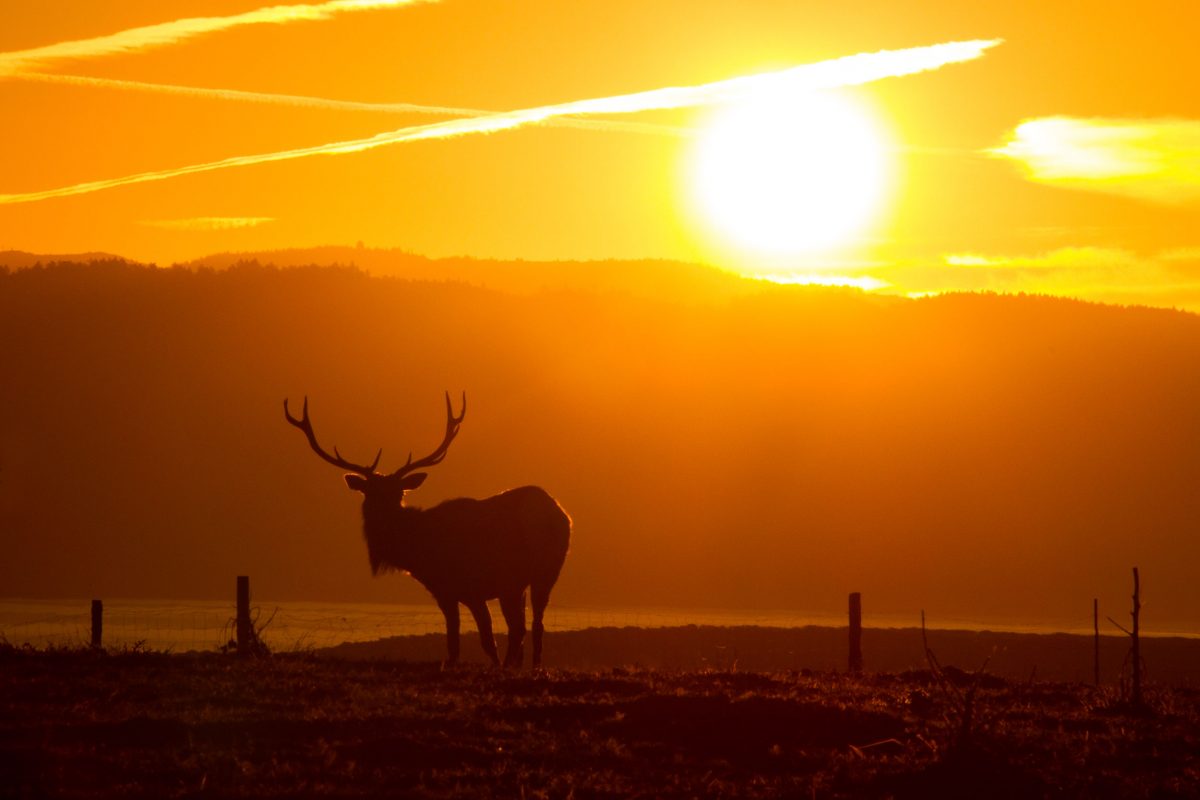
Dietrich’s photos and videos of tule elk in California’s Point Reyes National Seashore have helped protect the animals from a cull, but the battle isn’t over. Photo by Daniel Dietrich
Today, the conservationist has his sights set on protecting Point Reyes’s imperiled population of tule elk. Despite being a national park, Point Reyes is home to several large cattle ranches. Some of the owners of these ranches have long campaigned for the lethal removal of the park’s elk, arguing that the elk reduce the amount of grass available to their cattle. In 2018, a bill was introduced that, if passed, would have resulted in the culling of the park’s elk, and organizations opposing the bill made use of photos and videos provided by Dietrich in their campaign. Although that bill did not pass into law, the elk remain under threat. The National Park Service is currently considering a plan that would authorize an annual culling of the park’s tule elk.
On the last leg of his tour, Dietrich and I see a small herd of tule elk, grazing alongside cattle on a pasture overlooking the ocean. We watch as the elk wander the grassy hillside, their dark, statuesque forms silhouetted against the horizon.
“If that bill had passed, those elk would be dead,” Dietrich says, snapping a few shots of the herd using a powerful zoom lens.
On our way back to his car, Dietrich glances at a few of the photos he’d captured and smiles. Dietrich got the shots he’d wanted, and his subjects were none the wiser.

